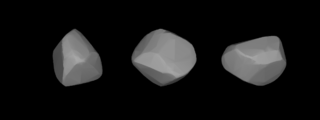| Asteroids discovered: 40 [1] | |
|---|---|
| 12061 Alena | March 21, 1998 |
| 12533 Edmond | June 2, 1998 |
| (13324) 1998 SK2 | September 18, 1998 |
| 13436 Enid | November 17, 1999 |
| 13688 Oklahoma | September 9, 1997 |
| (14165) 1998 UZ | October 19, 1998 |
| (15162) 2000 GN2 | April 5, 2000 |
| 15904 Halstead | September 29, 1997 |
| (16820) 1997 VA3 | November 6, 1997 |
| (18033) 1999 NR4 | July 14, 1999 |
| (19632) 1999 RP39 | September 13, 1999 |
| (22825) 1999 RO39 | September 13, 1999 |
| (23201) 2000 SJ42 | September 27, 2000 |
| (24095) 1999 VN | November 2, 1999 |
| (24107) 1999 VS19 | November 12, 1999 |
| (25357) 1999 TM | October 1, 1999 |
| (27085) 1998 UA1 | October 19, 1998 |
| (27219) 1999 EL | March 9, 1999 |
| (29822) 1999 DS2 | February 19, 1999 |
| (31246) 1998 DZ12 | February 24, 1998 |
| (33431) 1999 EK | March 9, 1999 |
| (39808) 1997 WQ25 | November 25, 1997 |
| (39842) 1998 BV25 | January 29, 1998 |
| (40171) 1998 RS | September 11, 1998 |
| (44474) 1998 WE | November 16, 1998 |
| (44478) 1998 WK6 | November 23, 1998 |
| (44886) 1999 VF1 | November 4, 1999 |
| (44903) 1999 VR19 | November 12, 1999 |
| (47030) 1998 VG32 | November 12, 1998 |
| (49297) 1998 VY4 | November 11, 1998 |
| (58584) 1997 SE11 | September 29, 1997 |
| (65889) 1998 BB4 | January 23, 1998 |
| (68009) 2000 YD4 | December 21, 2000 |
| (70426) 1999 TN | October 1, 1999 |
| (70733) 1999 VV6 | November 8, 1999 |
| (74791) 1999 SW6 | September 30, 1999 |
| (80249) 1999 WB9 | November 30, 1999 |
| (91906) 1999 VE24 | November 15, 1999 |
| (100640) 1997 VY3 | November 7, 1997 |
| (103576) 2000 CG1 | February 4, 2000 |
Tom Stafford is an American astronomer who has discovered a number of asteroids since 1997, [1] including 12061 Alena, [2] 12533 Edmond, [3] 13436 Enid, [4] 13688 Oklahoma [5] and 15904 Halstead [6] at Zeno Observatory (observatory code 727) in Edmond, Oklahoma. He is the son of Joseph W. Stafford and Alena Ruth Robbins, both now deceased, and has a sister, Susan Halstead. [7]

An astronomer is a scientist in the field of astronomy who focuses their studies on a specific question or field outside the scope of Earth. They observe astronomical objects such as stars, planets, moons, comets, and galaxies – in either observational or theoretical astronomy. Examples of topics or fields astronomers study include planetary science, solar astronomy, the origin or evolution of stars, or the formation of galaxies. Related but distinct subjects like physical cosmology, which studies the Universe as a whole.

Asteroids are minor planets, especially of the inner Solar System. Larger asteroids have also been called planetoids. These terms have historically been applied to any astronomical object orbiting the Sun that did not resemble a planet-like disc and was not observed to have characteristics of an active comet such as a tail. As minor planets in the outer Solar System were discovered they were typically found to have volatile-rich surfaces similar to comets. As a result, they were often distinguished from objects found in the main asteroid belt. In this article, the term "asteroid" refers to the minor planets of the inner Solar System including those co-orbital with Jupiter.

Edmond is a city in Oklahoma County, Oklahoma, United States, and a part of the Oklahoma City metropolitan area in the central part of the state. As of the 2010 census, the population was 81,405, making it the sixth largest city in the state of Oklahoma.



